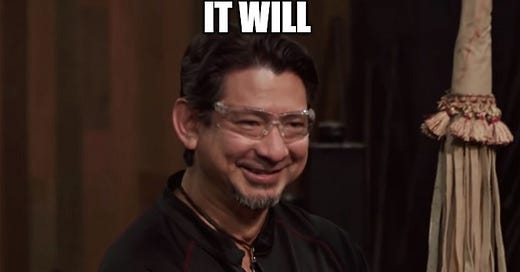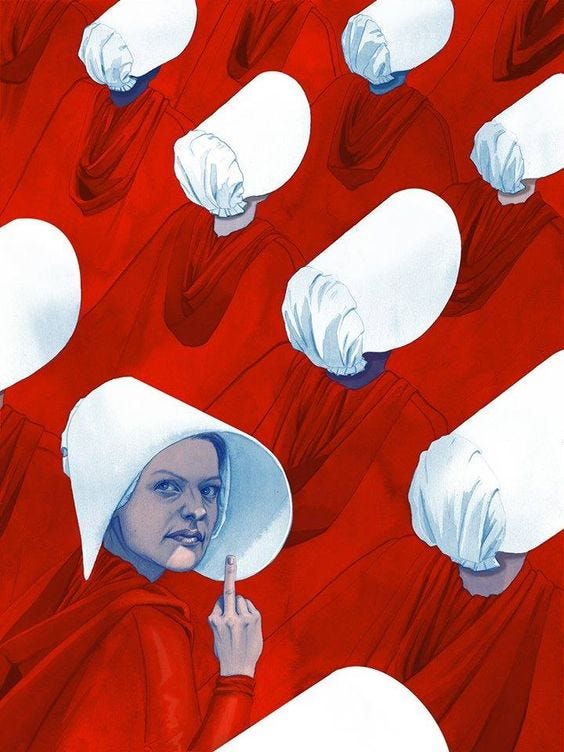While bored in quarantine, my boyfriend and I have binged several seasons of “Forged in Fire” on Netflix.
It’s a reality competition series where the majority male contestants, all amateur or professional blacksmiths (chock of macho bravado and beard sweat) smelt, beat, twist and forge blades to specific dimensions.
From there, the motley crew of judges test the blades on a variety of (often bizarre) “tough” objects: coconuts, horsehair, rugs, metal toys, barber chairs, whole pig carcasses, and “ballistics dummies” (nightmarish jello molds in the shape of a human torsos, complete with fake blood inside). I can tell that the show’s editors always want to focus on the contestant’s face as their knife is put to the test: will it cut? will it fall apart? how dangerous is this newly-forged knife anyway?
One particularly goofy judge, upon successfully cutting a ballistic dummy torso or pig carcass, always bows to the contestant after using the blade and tells them, in a somber-yet-smiling voice, “It will kill!” (which he intentionally over-pronounces to make it sound like “Eet wheel keel!”). And the contestant whose knife just passed the test inevitably sighs or laughs with relief. Their newly crafted knife could cause serious damage, huzzah!
“Forged in Fire” is supposed to be all about craftsmanship and artistry, but we’re constantly reminded that knives are primarily an instrument of death. It’s an unsettling juxtaposition: the goofiness of slashing a jelly torso just moments before a judge happily assures the contestant that their blade could successfully end the life of another human being.
I had a different newsletter planned for today, one I’d thought of before the attempted coupe that took place on January 6th. But then, on the afternoon of the 6th, I decided to take stock of our knives.
We have several everyday kitchen knives on a magnetic strip hung by our stovetop and cutting board; a spare utility knife; an old pocket knife; that tiny dull blade on the wine corkscrew; could scissors make an effective weapon? I actually found myself wondering that creepy question myself: “Will this kill?”
I’m not proud of this thinking. This is clear catastrophizing, where a person spirals out of control spurred by fear rather than substantiated evidence. In this case I have no concrete proof that I am in danger. I’m in Brooklyn, privileged and safe in my apartment, where the greatest threat to my physical well-being is my dog accidentally peeing down my shirt (which, unfortunately, did happen recently). The riots took place in D.C. When I look outside my window, the most dangerous thing I see is a toddler rolling headfirst down a playground slide across the street. In other words, there’s no reason to think the Qanon Trump extremists and Proud Boys and alt-right militias are barreling towards Crown Heights any time soon.
But then again I’m not the only one all taking stock of my inventory of potential weapons. In one of the most disturbing news podcast episodes I’ve ever heard, The Daily spoke to first-time gun buyers a few months ago who feared a civil war breaking out post-election. Several friends have informed me that they have “go-bags,” which were initially made famous by doomsday preppers. These go-bags are carefully curated with tools, rations, weapons, and utilitarian items needed in case of a potential national emergency and government collapse. Go-bags are supposed to eliminate the likely panic from being caught unprepared, especially when our government’s response has proven inadequate at best if not downright treasonous at worst.
Is there a way to rationally think about what to do in a potential impending insurrection? It’s a question that gives me goosebumps because I truly don’t have the faintest clue how to answer it. Frankly, it’s a real privilege I haven’t had to think this through all that much before now, certainly not in any serious capacity.
Violence is, of course, not always physical. You don’t need a knife, blade, or gun to cause trauma. Violence can be done by manipulation, by discrimination, by rendering the “other” as invisible or, in some cases, undeserving of being an American.
There’s the violence of seeing white supremacists treated tenderly as they were escorted out of the Capital, holding hands with cops after ransacking and desecrating the cradle of democracy.
There’s the emotional violence of hearing the cheeto-in-chief sending domestic terrorists mixed messages, telling them they are loved and that they are special rather than fully condemning their actions.
There’s the violence of the “what if’s” that live on long after the act of violence has stopped. AOC recently went on Instagram live to share a few details of her life-threatening experience during the Capital insurrection (she was unable to give many specific details due to ongoing national security risks). She is still struggling with the possibility of what might have happened to her that day, or what could happen in the future.
Is there a way to quantify the toll that violence—both physical and intangible—can take on us physically, emotionally, spiritually? Unlike the judges’ “tests” on “Forged in Fire,” how can we see the damage that has been done unto us as individuals and as a nation?
I pivot now to the original idea I’d had for this newsletter pre-January 6th: revisiting ACT UP’s Political Funerals in Washington, D.C. during the 1990s. But I swear, it’s still relevant.
ACT UP organized a protest on October 11th, 1992, consisting of a march that ended with a “funeral” demonstration outside the White House. This was meant as an alternative to more passive forms of protest such as the AIDS quilt displayed on the Washington Mall. Loved ones of deceased AIDS victims were encouraged carry the dead’s ashes, which they then threw on to the White House lawn through a fence. This particular form of protest would be repeated several times throughout the 1990s, and the photos of the murdered victim’s friends, lovers, partners, family members scattering the ashes over the fence never fails to move me to tears. It was highly emotional, devastating, profoundly angry protest, and no one got hurt when they did it.
Political funerals were a symbolic dragging of the dead to President George Bush’s door, a protest that was intended to remind him that he and his predecessor had blood on their hands. The cremains of the activists’ loved ones could, perhaps, been seen as a peaceful weapon, allowing them to express their anger and overwhelming despair. They didn’t pull out weapons, knives, guns. Activists brought evidence of the government’s homophobic neglect and harmful apathy in the form of ashes. After all, the government’s reluctance to address the AIDS epidemic and the advocacy of LGBT activists head-on was a form of violence too. It could be argued that these ashes were merely the byproduct of that neglect, being brought back to bear on the administrations who ignored the problem.
Now let me be very clear here: drawing an analogy between all of these events and tragedies isn’t great or even altogether parallel. The ACT UP Political Funerals arose out of 12 years of our federal government dismissing LGBTQ+ activists and the medical community.
It’s been less than a year since COVID-19 first arrived in the United States, and it has already needlessly taken the lives of approximately 350,000+ Americans. We’ve also seen the deaths of 5 people at the Capitol, thanks to Trump’s dangerous rhetoric and his support from GOP senators including Ted Cruz and Josh Hawley. This insurrection, it could be argued, is the result of four years of simmering conspiracy theories, increasingly overt white supremacy, and shared delusion. And it all boiled up due to a group of primarily white working-class men who saw themselves as the ignored, neglected victims of government apathy, social justice initiatives, and a society they are convinced has left them behind.
What I originally wanted to write in this essay-newsletter ultimately was this: we’ve held nonviolent protests and marches, we’ve voted, we’ve successfully petitioned Twitter to deactivate that asshole’s account for all eternity, but what will it take to feel safe again? Will it take a literal scattering of cremains—an angry, nonviolent outpouring of rage and grief and desperation—some place where Trump and the GOP can’t avoid them?
We already know that extremist militias and Qanon fanatics can murder their fellow Americans. That evidence has been televised. There is no need for a knife expert to use a hokey gimmick on TV to prove to us that the weapons these people carry (and the virus they spread by neglecting their masks, wielding potential illness as weapon) can kill. And they likely will try to kill again.
But when will the ashes of those we’ve lost—to illness, to lack of healthcare, to apathy, to failed leadership and preparation, to conspiracy-driven insurrection and violence—begin to appear on the White House lawn? When will Trump and the GOP acknowledge the bodies of those killed during an insurrection of their own making and a pandemic that raged on under their watch? Could they still refute the facts when they witness ashes floating in the wind? And, most importantly: can we achieve this without bloodshed?
We’ve gotta look out for ourselves and protest on behalf of others safely and without violence, but in the same breath we citizens pack go-bags, purchase weapons, and wait for the worst. But we commit to civil disobedience and nonviolent protest. We’ll keep on taking the few actions available to us, even when they feel futile, because that’s what’s right in the end.
When I greet this new administration (if the extremists don’t meddle with the inauguration first), I’ll have questions for them too:
When will we acknowledge the massive loss of human life due to COVID-19 (and now insurrection)? When will we acknowledge the trauma and damage it has caused?
Will there ever be a moment of public grieving (even if it doesn’t take the form of a political funeral)? There has been so much loss, incalculable in its scope. Can we allow space for both healing and reconciliation of some kind?
And if we as a country do finally get to mourn the wounds: Will I ever feel safe? Will my friends unpack their go-bags? Will I ever stop taking inventory of our knives?






